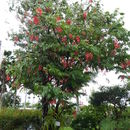Biology
(
英語
)
由Arkive提供
This tree is evergreen, meaning it retains its leaves year round. Flowering occurs from January to February (4).
Conservation
(
英語
)
由Arkive提供
The pride of Burma persists in cultivation, where it is widely grown as an ornamental (2).
Description
(
英語
)
由Arkive提供
This stunning tree is the only member of the genus Amherstia (4). The extravagant flowers are seen hanging from the long inflorescence, or flower stalk, which is a bright crimson red at the end (2). There are 5 petals although 2 of these are minute and the rest are of unequal size. The petals are also crimson; the two medium sized petals are yellow at the tip and the largest petal is broad and fan-shaped with a wavy upper margin and a yellow triangle of colour extending from the lip down into the flower (4). This large petal may be 7.5 centimetres long and over 4 centimetres wide at the end (2). There are either 9 or 10 stamens, 9 of which are partially fused into a pink sheath; the stamens are of two differing lengths with the longer ones having larger anthers (4). The compound leaves bear 6 - 8 large leaflets; these are broadly oblong in shape and are a whitish colour underneath (2). The fruits, or seedpods, are 11 to 20 centimetres long (3). They are roughly scimitar-shaped and the woody outer case opens to disperse the seeds (4).
Habitat
(
英語
)
由Arkive提供
Found in dry, evergreen forests (4).
Range
(
英語
)
由Arkive提供
Endemic to Burma in Southeast Asia, this species is often cultivated as an ornamental for its extremely showy flowers (2).
Status
(
英語
)
由Arkive提供
Not evaluated.
Threats
(
英語
)
由Arkive提供
This species was once relatively common in its native Burma (4); however, the current distribution and threats to its survival are unknown.

